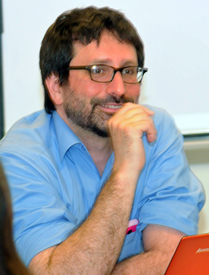Member Spotlight
Mel S. Sabella
Chicago State University, Chicago, IL
I joined AAPT many years ago when I was a physics graduate student at the University of Maryland, starting out in Physics Education Research (PER). My advisor, Joe Redish, said, "join AAPT," so I did. I attended my first AAPT conference that same year, auspiciously hosted at the University of Maryland. This was my first opportunity to meet the authors of the papers that I had been reading. The first AAPT workshop that I ever attended was given by Lillian McDermott and the Physics Education Group from the University of Washington. It was also during that AAPT meeting, 20 years ago, that I met other graduate students in PER from around the country, many of whom I collaborate with today. AAPT has always been my professional home, made up of colleagues and friends that I greatly respect, value, and enjoy being around. It's a great feeling to go to an AAPT meeting and feel at home.
My membership in AAPT has been an essential piece of career building: it is the main conference for the professional community that I belong to. AAPT is where I learn about new research in my field, connect to and collaborate with colleagues, and have an opportunity to talk about my work. The vast majority of my current collaborations have come from interactions at either the national AAPT meetings or our local Chicago and Illinois section meetings. AAPT is also where I get inspired. I often get so excited at AAPT meetings that I arrive back to my home institution wanting to incorporate everything I've learned! Incorporating everything takes time and I've learned over the years that I need to bring back one or two items and make changes to my teaching and research slowly and reflectively.The diversity in the AAPT community has also helped me in my career. This diversity is centered around AAPT's common overarching goal: How can we improve physics instruction to be more effective, supportive, and welcoming for all our students? Not only do I get to interact with others in physics education researcher, but my teaching and research are also informed by the perspectives of high school teachers, two year college faculty, and faculty from a wide variety of four year colleges and universities. It is also important to highlight that AAPT members come from around the world, so I can gain insight into common struggles and unique perspectives outside of the U.S.
I think that one of the main ways that I contribute to physics education is by amplifying the voices, experiences, and strengths of my students at Chicago State University - students who are traditionally underrepresented in physics at all levels. Chicago State University is a Predominately Black Institution (PBI) serving the population on the southside of Chicago. I can remember starting out as a new physics faculty member there and teaching my first physics class: introductory algebra-based physics. It's not always the case that students are on board with active learning. I remember being so excited by the enthusiasm that my students had for inquiry and the way they supported one another in the class. My students embraced this type of learning environment and the classroom was always full of energy and discussion. It was because of my experience with CSU students that I started really thinking about the resources and culture that my students were bringing to the classroom, rather than mainly focusing on student difficulties. I started to think more about how the broad science community could benefit by incorporating some of the skills that my students had in the science classroom. My students know their peers very well, often sharing common experiences and similar obstacles, so it is key for me to partner with my students in improving education. I regularly involve students in my education research and have learned a tremendous amount from them. Additionally, my pre-service teaching students will often design lessons that draw on their experiences growing up in the communities that they will most likely teach in - a cultural expertise that they bring to the table. AAPT is an important venue for students to have voice and leadership when it comes to teaching and learning physics. I love to bring my undergraduate researchers from CSU to AAPT meetings so that they can both provide their insight and learn from others. AAPT does an excellent job of valuing the work of diverse communities and I hope that CSU, and other institutions like it, continue to contribute to the mission and goals of AAPT.


